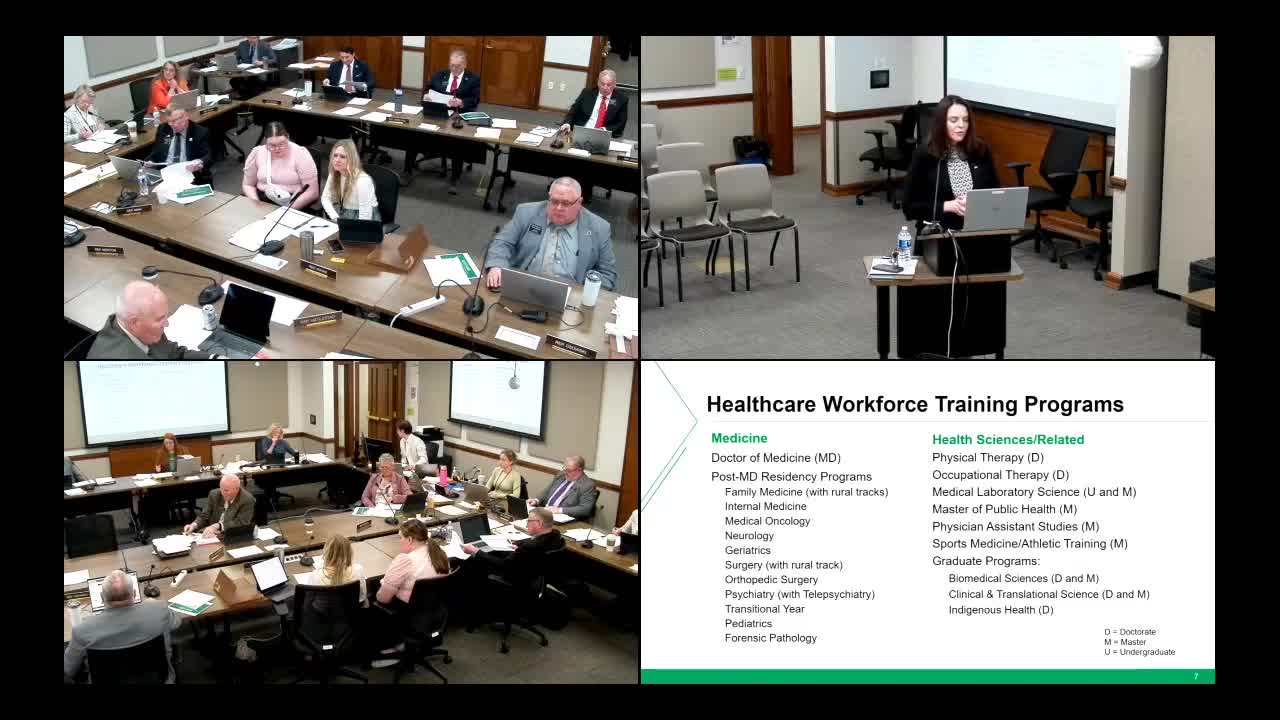North Dakota medical school achieves 29% student growth and expands health programs
March 11, 2025 | Education, House of Representatives, Legislative, North Dakota
This article was created by AI summarizing key points discussed. AI makes mistakes, so for full details and context, please refer to the video of the full meeting. Please report any errors so we can fix them. Report an error »

The North Dakota State Legislature convened on March 11, 2025, for a House Education meeting focused on the growth and impact of the state's medical education programs. The session highlighted the significant contributions of local medical schools to healthcare in North Dakota, particularly in training and retaining healthcare professionals.
The meeting began with a presentation from a representative of the medical school, who emphasized the vital role of occupational and physical therapists in the community, especially for patients recovering from strokes or surgeries. The speaker noted that many healthcare services, including lab tests, are conducted by students from the medical school, showcasing the institution's integration into the local healthcare system.
A key point of discussion was the impressive growth of the medical school, which has seen a 29% increase in medical students and a near doubling of residency programs. The representative highlighted that training students in-state significantly increases the likelihood of them remaining in North Dakota, with a 75% retention rate for those who complete their residency locally, compared to less than 50% for those who only attend medical school in the state.
The meeting also addressed the success of the medical school's alumni, with 79% of family physicians in North Dakota being graduates of the program. The representative expressed pride in the institution's ability to produce a significant portion of the state's healthcare workforce, including occupational therapists, physical therapists, lab scientists, and physician assistants.
Additionally, the medical school operates clinical facilities in Bismarck and Minot, where they provide care and training for thousands of patients. The speaker emphasized the importance of accessible training across the state, noting that simulation training is utilized to prepare students for real-world medical scenarios. This includes high-fidelity mannequins that simulate various medical conditions, enhancing the training experience.
The meeting concluded with a discussion on the outreach efforts of the medical school, including the SIMND program, which has trained over 30,000 individuals in trauma scenarios across North Dakota. This initiative aims to keep healthcare professionals' skills sharp and ready for emergencies.
Overall, the meeting underscored the critical role of the medical school in addressing healthcare needs in North Dakota and the ongoing commitment to training and retaining skilled professionals in the state.
The meeting began with a presentation from a representative of the medical school, who emphasized the vital role of occupational and physical therapists in the community, especially for patients recovering from strokes or surgeries. The speaker noted that many healthcare services, including lab tests, are conducted by students from the medical school, showcasing the institution's integration into the local healthcare system.
A key point of discussion was the impressive growth of the medical school, which has seen a 29% increase in medical students and a near doubling of residency programs. The representative highlighted that training students in-state significantly increases the likelihood of them remaining in North Dakota, with a 75% retention rate for those who complete their residency locally, compared to less than 50% for those who only attend medical school in the state.
The meeting also addressed the success of the medical school's alumni, with 79% of family physicians in North Dakota being graduates of the program. The representative expressed pride in the institution's ability to produce a significant portion of the state's healthcare workforce, including occupational therapists, physical therapists, lab scientists, and physician assistants.
Additionally, the medical school operates clinical facilities in Bismarck and Minot, where they provide care and training for thousands of patients. The speaker emphasized the importance of accessible training across the state, noting that simulation training is utilized to prepare students for real-world medical scenarios. This includes high-fidelity mannequins that simulate various medical conditions, enhancing the training experience.
The meeting concluded with a discussion on the outreach efforts of the medical school, including the SIMND program, which has trained over 30,000 individuals in trauma scenarios across North Dakota. This initiative aims to keep healthcare professionals' skills sharp and ready for emergencies.
Overall, the meeting underscored the critical role of the medical school in addressing healthcare needs in North Dakota and the ongoing commitment to training and retaining skilled professionals in the state.
View full meeting
This article is based on a recent meeting—watch the full video and explore the complete transcript for deeper insights into the discussion.
View full meeting
